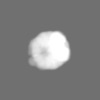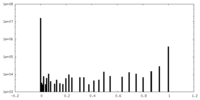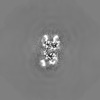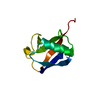[English] 日本語
 Yorodumi
Yorodumi- EMDB-41707: Cryo-EM structure of the human nucleosome core particle ubiquityl... -
+ Open data
Open data
- Basic information
Basic information
| Entry |  | |||||||||
|---|---|---|---|---|---|---|---|---|---|---|
| Title | Cryo-EM structure of the human nucleosome core particle ubiquitylated at histone H2A K15 in complex with RNF168 (Class 2) | |||||||||
 Map data Map data | ||||||||||
 Sample Sample |
| |||||||||
 Keywords Keywords | Nucleosome core particle / chromatin / RNF168 / MIU2-LRM domains / DNA repair / DNA double-strand break / Homologous recombination / BRCA1-BARD1 / 53BP1 / ubiquitin / STRUCTURAL PROTEIN-DNA-TRANSFERASE complex / TRANSFERASE | |||||||||
| Function / homology |  Function and homology information Function and homology informationhistone H2AK15 ubiquitin ligase activity / histone ubiquitin ligase activity / double-strand break repair via classical nonhomologous end joining / isotype switching / hypothalamus gonadotrophin-releasing hormone neuron development / female meiosis I / positive regulation of protein monoubiquitination / fat pad development / mitochondrion transport along microtubule / K63-linked polyubiquitin modification-dependent protein binding ...histone H2AK15 ubiquitin ligase activity / histone ubiquitin ligase activity / double-strand break repair via classical nonhomologous end joining / isotype switching / hypothalamus gonadotrophin-releasing hormone neuron development / female meiosis I / positive regulation of protein monoubiquitination / fat pad development / mitochondrion transport along microtubule / K63-linked polyubiquitin modification-dependent protein binding / response to ionizing radiation / female gonad development / DNA repair-dependent chromatin remodeling / seminiferous tubule development / male meiosis I / negative regulation of transcription elongation by RNA polymerase II / positive regulation of intrinsic apoptotic signaling pathway by p53 class mediator / protein K63-linked ubiquitination / ubiquitin ligase complex / interstrand cross-link repair / SUMOylation of DNA damage response and repair proteins / negative regulation of megakaryocyte differentiation / protein localization to CENP-A containing chromatin / nucleosome binding / energy homeostasis / Chromatin modifying enzymes / Replacement of protamines by nucleosomes in the male pronucleus / regulation of neuron apoptotic process / neuron projection morphogenesis / CENP-A containing nucleosome / regulation of proteasomal protein catabolic process / Packaging Of Telomere Ends / Maturation of protein E / Maturation of protein E / ER Quality Control Compartment (ERQC) / Myoclonic epilepsy of Lafora / Recognition and association of DNA glycosylase with site containing an affected purine / Cleavage of the damaged purine / FLT3 signaling by CBL mutants / IRAK2 mediated activation of TAK1 complex / Prevention of phagosomal-lysosomal fusion / Alpha-protein kinase 1 signaling pathway / Glycogen synthesis / IRAK1 recruits IKK complex / IRAK1 recruits IKK complex upon TLR7/8 or 9 stimulation / Endosomal Sorting Complex Required For Transport (ESCRT) / Deposition of new CENPA-containing nucleosomes at the centromere / Membrane binding and targetting of GAG proteins / Negative regulation of FLT3 / Regulation of TBK1, IKKε (IKBKE)-mediated activation of IRF3, IRF7 / PTK6 Regulates RTKs and Their Effectors AKT1 and DOK1 / Regulation of TBK1, IKKε-mediated activation of IRF3, IRF7 upon TLR3 ligation / Constitutive Signaling by NOTCH1 HD Domain Mutants / IRAK2 mediated activation of TAK1 complex upon TLR7/8 or 9 stimulation / NOTCH2 Activation and Transmission of Signal to the Nucleus / TICAM1,TRAF6-dependent induction of TAK1 complex / TICAM1-dependent activation of IRF3/IRF7 / APC/C:Cdc20 mediated degradation of Cyclin B / telomere organization / Recognition and association of DNA glycosylase with site containing an affected pyrimidine / Cleavage of the damaged pyrimidine / Downregulation of ERBB4 signaling / Regulation of FZD by ubiquitination / APC-Cdc20 mediated degradation of Nek2A / Interleukin-7 signaling / p75NTR recruits signalling complexes / InlA-mediated entry of Listeria monocytogenes into host cells / RNA Polymerase I Promoter Opening / TRAF6 mediated IRF7 activation in TLR7/8 or 9 signaling / TRAF6-mediated induction of TAK1 complex within TLR4 complex / Regulation of pyruvate metabolism / NF-kB is activated and signals survival / Regulation of innate immune responses to cytosolic DNA / Pexophagy / Downregulation of ERBB2:ERBB3 signaling / epigenetic regulation of gene expression / Inhibition of DNA recombination at telomere / NRIF signals cell death from the nucleus / Assembly of the ORC complex at the origin of replication / VLDLR internalisation and degradation / Regulation of PTEN localization / Meiotic synapsis / positive regulation of DNA repair / Activated NOTCH1 Transmits Signal to the Nucleus / SUMOylation of chromatin organization proteins / Regulation of endogenous retroelements by the Human Silencing Hub (HUSH) complex / Regulation of BACH1 activity / Synthesis of active ubiquitin: roles of E1 and E2 enzymes / MAP3K8 (TPL2)-dependent MAPK1/3 activation / Translesion synthesis by REV1 / TICAM1, RIP1-mediated IKK complex recruitment / DNA methylation / Translesion synthesis by POLK / InlB-mediated entry of Listeria monocytogenes into host cell / Activation of IRF3, IRF7 mediated by TBK1, IKKε (IKBKE) / JNK (c-Jun kinases) phosphorylation and activation mediated by activated human TAK1 / Condensation of Prophase Chromosomes / Downregulation of TGF-beta receptor signaling / ubiquitin binding / Josephin domain DUBs Similarity search - Function | |||||||||
| Biological species |  Homo sapiens (human) Homo sapiens (human) | |||||||||
| Method | single particle reconstruction / cryo EM / Resolution: 3.6 Å | |||||||||
 Authors Authors | Hu Q / Botuyan MV / Zhao D / Cui G / Mer G | |||||||||
| Funding support |  United States, 2 items United States, 2 items
| |||||||||
 Citation Citation |  Journal: Mol Cell / Year: 2024 Journal: Mol Cell / Year: 2024Title: Mechanisms of RNF168 nucleosome recognition and ubiquitylation. Authors: Qi Hu / Debiao Zhao / Gaofeng Cui / Janarjan Bhandari / James R Thompson / Maria Victoria Botuyan / Georges Mer /  Abstract: RNF168 plays a central role in the DNA damage response (DDR) by ubiquitylating histone H2A at K13 and K15. These modifications direct BRCA1-BARD1 and 53BP1 foci formation in chromatin, essential for ...RNF168 plays a central role in the DNA damage response (DDR) by ubiquitylating histone H2A at K13 and K15. These modifications direct BRCA1-BARD1 and 53BP1 foci formation in chromatin, essential for cell-cycle-dependent DNA double-strand break (DSB) repair pathway selection. The mechanism by which RNF168 catalyzes the targeted accumulation of H2A ubiquitin conjugates to form repair foci around DSBs remains unclear. Here, using cryoelectron microscopy (cryo-EM), nuclear magnetic resonance (NMR) spectroscopy, and functional assays, we provide a molecular description of the reaction cycle and dynamics of RNF168 as it modifies the nucleosome and recognizes its ubiquitylation products. We demonstrate an interaction of a canonical ubiquitin-binding domain within full-length RNF168, which not only engages ubiquitin but also the nucleosome surface, clarifying how such site-specific ubiquitin recognition propels a signal amplification loop. Beyond offering mechanistic insights into a key DDR protein, our study aids in understanding site specificity in both generating and interpreting chromatin ubiquitylation. | |||||||||
| History |
|
- Structure visualization
Structure visualization
| Supplemental images |
|---|
- Downloads & links
Downloads & links
-EMDB archive
| Map data |  emd_41707.map.gz emd_41707.map.gz | 4.2 MB |  EMDB map data format EMDB map data format | |
|---|---|---|---|---|
| Header (meta data) |  emd-41707-v30.xml emd-41707-v30.xml emd-41707.xml emd-41707.xml | 28.3 KB 28.3 KB | Display Display |  EMDB header EMDB header |
| Images |  emd_41707.png emd_41707.png | 126.5 KB | ||
| Masks |  emd_41707_msk_1.map emd_41707_msk_1.map | 64 MB |  Mask map Mask map | |
| Filedesc metadata |  emd-41707.cif.gz emd-41707.cif.gz | 7.7 KB | ||
| Others |  emd_41707_additional_1.map.gz emd_41707_additional_1.map.gz emd_41707_half_map_1.map.gz emd_41707_half_map_1.map.gz emd_41707_half_map_2.map.gz emd_41707_half_map_2.map.gz | 37.6 MB 49.9 MB 49.9 MB | ||
| Archive directory |  http://ftp.pdbj.org/pub/emdb/structures/EMD-41707 http://ftp.pdbj.org/pub/emdb/structures/EMD-41707 ftp://ftp.pdbj.org/pub/emdb/structures/EMD-41707 ftp://ftp.pdbj.org/pub/emdb/structures/EMD-41707 | HTTPS FTP |
-Validation report
| Summary document |  emd_41707_validation.pdf.gz emd_41707_validation.pdf.gz | 754.7 KB | Display |  EMDB validaton report EMDB validaton report |
|---|---|---|---|---|
| Full document |  emd_41707_full_validation.pdf.gz emd_41707_full_validation.pdf.gz | 754.3 KB | Display | |
| Data in XML |  emd_41707_validation.xml.gz emd_41707_validation.xml.gz | 11.9 KB | Display | |
| Data in CIF |  emd_41707_validation.cif.gz emd_41707_validation.cif.gz | 14 KB | Display | |
| Arichive directory |  https://ftp.pdbj.org/pub/emdb/validation_reports/EMD-41707 https://ftp.pdbj.org/pub/emdb/validation_reports/EMD-41707 ftp://ftp.pdbj.org/pub/emdb/validation_reports/EMD-41707 ftp://ftp.pdbj.org/pub/emdb/validation_reports/EMD-41707 | HTTPS FTP |
-Related structure data
| Related structure data | 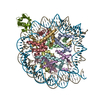 8txwMC  8smwC  8smxC  8smyC  8smzC  8sn0C  8sn1C  8sn2C 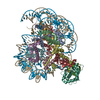 8sn3C  8sn4C  8sn5C  8sn6C  8sn7C  8sn8C  8sn9C 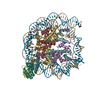 8snaC 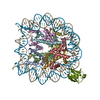 8txvC 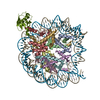 8txxC 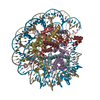 8u13C  8u14C  8upfC 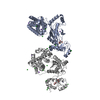 8uq8C 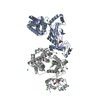 8uq9C 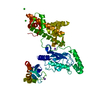 8uqaC 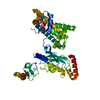 8uqbC 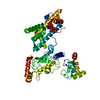 8uqcC 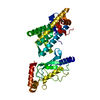 8uqdC 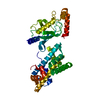 8uqeC M: atomic model generated by this map C: citing same article ( |
|---|---|
| Similar structure data | Similarity search - Function & homology  F&H Search F&H Search |
- Links
Links
| EMDB pages |  EMDB (EBI/PDBe) / EMDB (EBI/PDBe) /  EMDataResource EMDataResource |
|---|---|
| Related items in Molecule of the Month |
- Map
Map
| File |  Download / File: emd_41707.map.gz / Format: CCP4 / Size: 64 MB / Type: IMAGE STORED AS FLOATING POINT NUMBER (4 BYTES) Download / File: emd_41707.map.gz / Format: CCP4 / Size: 64 MB / Type: IMAGE STORED AS FLOATING POINT NUMBER (4 BYTES) | ||||||||||||||||||||||||||||||||||||
|---|---|---|---|---|---|---|---|---|---|---|---|---|---|---|---|---|---|---|---|---|---|---|---|---|---|---|---|---|---|---|---|---|---|---|---|---|---|
| Projections & slices | Image control
Images are generated by Spider. | ||||||||||||||||||||||||||||||||||||
| Voxel size | X=Y=Z: 1.328 Å | ||||||||||||||||||||||||||||||||||||
| Density |
| ||||||||||||||||||||||||||||||||||||
| Symmetry | Space group: 1 | ||||||||||||||||||||||||||||||||||||
| Details | EMDB XML:
|
-Supplemental data
-Mask #1
| File |  emd_41707_msk_1.map emd_41707_msk_1.map | ||||||||||||
|---|---|---|---|---|---|---|---|---|---|---|---|---|---|
| Projections & Slices |
| ||||||||||||
| Density Histograms |
-Additional map: #1
| File | emd_41707_additional_1.map | ||||||||||||
|---|---|---|---|---|---|---|---|---|---|---|---|---|---|
| Projections & Slices |
| ||||||||||||
| Density Histograms |
-Half map: #1
| File | emd_41707_half_map_1.map | ||||||||||||
|---|---|---|---|---|---|---|---|---|---|---|---|---|---|
| Projections & Slices |
| ||||||||||||
| Density Histograms |
-Half map: #2
| File | emd_41707_half_map_2.map | ||||||||||||
|---|---|---|---|---|---|---|---|---|---|---|---|---|---|
| Projections & Slices |
| ||||||||||||
| Density Histograms |
- Sample components
Sample components
-Entire : Human nucleosome core particle ubiquitylated at histone H2A K15 i...
| Entire | Name: Human nucleosome core particle ubiquitylated at histone H2A K15 in complex with RNF168 (Class 2) |
|---|---|
| Components |
|
-Supramolecule #1: Human nucleosome core particle ubiquitylated at histone H2A K15 i...
| Supramolecule | Name: Human nucleosome core particle ubiquitylated at histone H2A K15 in complex with RNF168 (Class 2) type: complex / ID: 1 / Parent: 0 / Macromolecule list: #1-#8 |
|---|---|
| Source (natural) | Organism:  Homo sapiens (human) Homo sapiens (human) |
| Molecular weight | Theoretical: 280 KDa |
-Macromolecule #1: Histone H3.1
| Macromolecule | Name: Histone H3.1 / type: protein_or_peptide / ID: 1 / Number of copies: 2 / Enantiomer: LEVO |
|---|---|
| Source (natural) | Organism:  Homo sapiens (human) Homo sapiens (human) |
| Molecular weight | Theoretical: 15.786534 KDa |
| Recombinant expression | Organism:  |
| Sequence | String: GPGHMARTKQ TARKSTGGKA PRKQLATKAA RKSAPATGGV KKPHRYRPGT VALREIRRYQ KSTELLIRKL PFQRLVREIA QDFKTDLRF QSSAVMALQE ACEAYLVGLF EDTNLCAIHA KRVTIMPKDI QLARRIRGER A UniProtKB: Histone H3.1 |
-Macromolecule #2: Histone H4
| Macromolecule | Name: Histone H4 / type: protein_or_peptide / ID: 2 / Number of copies: 2 / Enantiomer: LEVO |
|---|---|
| Source (natural) | Organism:  Homo sapiens (human) Homo sapiens (human) |
| Molecular weight | Theoretical: 11.743792 KDa |
| Recombinant expression | Organism:  |
| Sequence | String: GPGHMSGRGK GGKGLGKGGA KRHRKVLRDN IQGITKPAIR RLARRGGVKR ISGLIYEETR GVLKVFLENV IRDAVTYTEH AKRKTVTAM DVVYALKRQG RTLYGFGG UniProtKB: Histone H4 |
-Macromolecule #3: Histone H2B type 1-C/E/F/G/I
| Macromolecule | Name: Histone H2B type 1-C/E/F/G/I / type: protein_or_peptide / ID: 3 / Number of copies: 2 / Enantiomer: LEVO |
|---|---|
| Source (natural) | Organism:  Homo sapiens (human) Homo sapiens (human) |
| Molecular weight | Theoretical: 14.084348 KDa |
| Recombinant expression | Organism:  |
| Sequence | String: GPGHMPEPAK SAPAPKKGSK KAVTKAQKKD GKKRKRSRKE SYSIYVYKVL KQVHPDTGIS SKAMGIMNSF VNDIFERIAG EASRLAHYN KRSTITSREI QTAVRLLLPG ELAKHAVSEG TKAVTKYTS UniProtKB: Histone H2B type 1-C/E/F/G/I |
-Macromolecule #6: E3 ubiquitin-protein ligase RNF168
| Macromolecule | Name: E3 ubiquitin-protein ligase RNF168 / type: protein_or_peptide / ID: 6 / Number of copies: 1 / Enantiomer: LEVO |
|---|---|
| Source (natural) | Organism:  Homo sapiens (human) Homo sapiens (human) |
| Molecular weight | Theoretical: 66.16818 KDa |
| Recombinant expression | Organism:  |
| Sequence | String: GPGMALPKDA IPSLSECQCG ICMEILVEPV TLPCNHTLCK PCFQSTVEKA SLCCPFCRRR VSSWTRYHTR RNSLVNVELW TIIQKHYPR ECKLRASGQE SEEVADDYQP VRLLSKPGEL RREYEEEISK VAAERRASEE EENKASEEYI QRLLAEEEEE E KRQAEKRR ...String: GPGMALPKDA IPSLSECQCG ICMEILVEPV TLPCNHTLCK PCFQSTVEKA SLCCPFCRRR VSSWTRYHTR RNSLVNVELW TIIQKHYPR ECKLRASGQE SEEVADDYQP VRLLSKPGEL RREYEEEISK VAAERRASEE EENKASEEYI QRLLAEEEEE E KRQAEKRR RAMEEQLKSD EELARKLSID INNFCEGSIS ASPLNSRKSD PVTPKSEKKS KNKQRNTGDI QKYLTPKSQF GS ASHSEAV QEVRKDSVSK DIDSSDRKSP TGQDTEIEDM PTLSPQISLG VGEQGADSSI ESPMPWLCAC GAEWYHEGNV KTR PSNHGK ELCVLSHERP KTRVPYSKET AVMPCGRTES GCAPTSGVTQ TNGNNTGETE NEESCLLISK EISKRKNQES SFEA VKDPC FSAKRRKVSP ESSPDQEETE INFTQKLIDL EHLLFERHKQ EEQDRLLALQ LQKEVDKEQM VPNRQKGSPD EYHLR ATSS PPDKVLNGQR KNPKDGNFKR QTHTKHPTPE RGSRDKNRQV SLKMQLKQSV NRRKMPNSTR DHCKVSKSAH SLQPSI SQK SVFQMFQRCT KHHHHHH UniProtKB: E3 ubiquitin-protein ligase RNF168 |
-Macromolecule #7: Polyubiquitin-B
| Macromolecule | Name: Polyubiquitin-B / type: protein_or_peptide / ID: 7 / Number of copies: 1 / Enantiomer: LEVO |
|---|---|
| Source (natural) | Organism:  Homo sapiens (human) Homo sapiens (human) |
| Molecular weight | Theoretical: 9.057391 KDa |
| Recombinant expression | Organism:  |
| Sequence | String: GPGHMMQIFV KTLTGKTITL EVEPSDTIEN VKAKIQDKEG IPPDQQRLIF AGKQLEDGRT LSDYNIQKES TLHLVLRLRG G UniProtKB: Polyubiquitin-B |
-Macromolecule #8: Histone H2A type 1-B/E
| Macromolecule | Name: Histone H2A type 1-B/E / type: protein_or_peptide / ID: 8 / Number of copies: 2 / Enantiomer: LEVO |
|---|---|
| Source (natural) | Organism:  Homo sapiens (human) Homo sapiens (human) |
| Molecular weight | Theoretical: 12.992091 KDa |
| Recombinant expression | Organism:  |
| Sequence | String: SASAKTRSSR AGLQFPVGRV HRLLRKGNYS ERVGAGAPVY LAAVLEYLTA EILELAGNAA RDNKKTRIIP RHLQLAIRND EELNKLLGR VTIAQGGVLP NIQAVLLPKK TESHHKAKGK UniProtKB: Histone H2A type 1-B/E |
-Macromolecule #4: DNA (147-MER)
| Macromolecule | Name: DNA (147-MER) / type: dna / ID: 4 / Number of copies: 1 / Classification: DNA |
|---|---|
| Source (natural) | Organism:  Homo sapiens (human) Homo sapiens (human) |
| Molecular weight | Theoretical: 45.13877 KDa |
| Sequence | String: (DA)(DT)(DC)(DG)(DA)(DG)(DA)(DA)(DT)(DC) (DC)(DC)(DG)(DG)(DT)(DG)(DC)(DC)(DG)(DA) (DG)(DG)(DC)(DC)(DG)(DC)(DT)(DC)(DA) (DA)(DT)(DT)(DG)(DG)(DT)(DC)(DG)(DT)(DA) (DG) (DA)(DC)(DA)(DG)(DC)(DT) ...String: (DA)(DT)(DC)(DG)(DA)(DG)(DA)(DA)(DT)(DC) (DC)(DC)(DG)(DG)(DT)(DG)(DC)(DC)(DG)(DA) (DG)(DG)(DC)(DC)(DG)(DC)(DT)(DC)(DA) (DA)(DT)(DT)(DG)(DG)(DT)(DC)(DG)(DT)(DA) (DG) (DA)(DC)(DA)(DG)(DC)(DT)(DC)(DT) (DA)(DG)(DC)(DA)(DC)(DC)(DG)(DC)(DT)(DT) (DA)(DA) (DA)(DC)(DG)(DC)(DA)(DC)(DG) (DT)(DA)(DC)(DG)(DC)(DG)(DC)(DT)(DG)(DT) (DC)(DC)(DC) (DC)(DC)(DG)(DC)(DG)(DT) (DT)(DT)(DT)(DA)(DA)(DC)(DC)(DG)(DC)(DC) (DA)(DA)(DG)(DG) (DG)(DG)(DA)(DT)(DT) (DA)(DC)(DT)(DC)(DC)(DC)(DT)(DA)(DG)(DT) (DC)(DT)(DC)(DC)(DA) (DG)(DG)(DC)(DA) (DC)(DG)(DT)(DG)(DT)(DC)(DA)(DG)(DA)(DT) (DA)(DT)(DA)(DT)(DA)(DC) (DA)(DT)(DC) (DC)(DG)(DA)(DT) |
-Macromolecule #5: DNA (147-MER)
| Macromolecule | Name: DNA (147-MER) / type: dna / ID: 5 / Number of copies: 1 / Classification: DNA |
|---|---|
| Source (natural) | Organism:  Homo sapiens (human) Homo sapiens (human) |
| Molecular weight | Theoretical: 45.610043 KDa |
| Sequence | String: (DA)(DT)(DC)(DG)(DG)(DA)(DT)(DG)(DT)(DA) (DT)(DA)(DT)(DA)(DT)(DC)(DT)(DG)(DA)(DC) (DA)(DC)(DG)(DT)(DG)(DC)(DC)(DT)(DG) (DG)(DA)(DG)(DA)(DC)(DT)(DA)(DG)(DG)(DG) (DA) (DG)(DT)(DA)(DA)(DT)(DC) ...String: (DA)(DT)(DC)(DG)(DG)(DA)(DT)(DG)(DT)(DA) (DT)(DA)(DT)(DA)(DT)(DC)(DT)(DG)(DA)(DC) (DA)(DC)(DG)(DT)(DG)(DC)(DC)(DT)(DG) (DG)(DA)(DG)(DA)(DC)(DT)(DA)(DG)(DG)(DG) (DA) (DG)(DT)(DA)(DA)(DT)(DC)(DC)(DC) (DC)(DT)(DT)(DG)(DG)(DC)(DG)(DG)(DT)(DT) (DA)(DA) (DA)(DA)(DC)(DG)(DC)(DG)(DG) (DG)(DG)(DG)(DA)(DC)(DA)(DG)(DC)(DG)(DC) (DG)(DT)(DA) (DC)(DG)(DT)(DG)(DC)(DG) (DT)(DT)(DT)(DA)(DA)(DG)(DC)(DG)(DG)(DT) (DG)(DC)(DT)(DA) (DG)(DA)(DG)(DC)(DT) (DG)(DT)(DC)(DT)(DA)(DC)(DG)(DA)(DC)(DC) (DA)(DA)(DT)(DT)(DG) (DA)(DG)(DC)(DG) (DG)(DC)(DC)(DT)(DC)(DG)(DG)(DC)(DA)(DC) (DC)(DG)(DG)(DG)(DA)(DT) (DT)(DC)(DT) (DC)(DG)(DA)(DT) |
-Experimental details
-Structure determination
| Method | cryo EM |
|---|---|
 Processing Processing | single particle reconstruction |
| Aggregation state | particle |
- Sample preparation
Sample preparation
| Concentration | 0.25 mg/mL |
|---|---|
| Buffer | pH: 7.5 |
| Grid | Model: Quantifoil R1.2/1.3 / Material: COPPER / Pretreatment - Type: GLOW DISCHARGE / Pretreatment - Time: 60 sec. |
| Vitrification | Cryogen name: ETHANE / Chamber humidity: 100 % / Chamber temperature: 277 K / Instrument: FEI VITROBOT MARK IV |
| Details | 10 mM HEPES, 100 mM NaCl, 1 mM DTT, pH 7.5 |
- Electron microscopy
Electron microscopy
| Microscope | FEI TITAN KRIOS |
|---|---|
| Image recording | Film or detector model: GATAN K3 BIOQUANTUM (6k x 4k) / Number grids imaged: 1 / Number real images: 11712 / Average electron dose: 50.0 e/Å2 Details: 11712 images were recorded in movie-mode of which 10993 were retained for particle picking. |
| Electron beam | Acceleration voltage: 300 kV / Electron source:  FIELD EMISSION GUN FIELD EMISSION GUN |
| Electron optics | Illumination mode: FLOOD BEAM / Imaging mode: BRIGHT FIELD / Cs: 2.7 mm / Nominal defocus max: 3.0 µm / Nominal defocus min: 0.5 µm / Nominal magnification: 130000 |
| Sample stage | Specimen holder model: FEI TITAN KRIOS AUTOGRID HOLDER / Cooling holder cryogen: NITROGEN |
| Experimental equipment |  Model: Titan Krios / Image courtesy: FEI Company |
+ Image processing
Image processing
-Atomic model buiding 1
| Initial model |
| ||||||
|---|---|---|---|---|---|---|---|
| Refinement | Space: REAL / Protocol: RIGID BODY FIT | ||||||
| Output model |  PDB-8txw: |
 Movie
Movie Controller
Controller


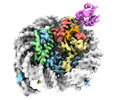


































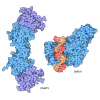





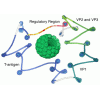




 Z (Sec.)
Z (Sec.) Y (Row.)
Y (Row.) X (Col.)
X (Col.)






















